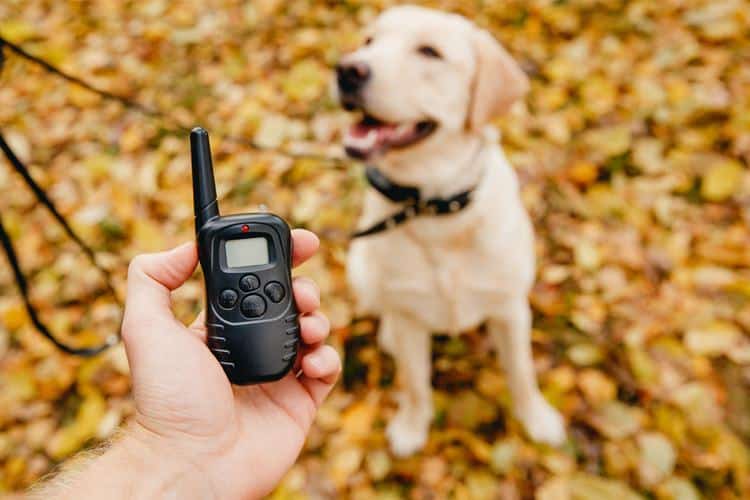Dog training collars, also known as e-collars or shock collars, are commonly used tools for a variety of training purposes. Whether you want to train your dog not to bark when guests come to your home, to obey commands, walk on a loose leash, field recall, leash training a puppy, or more sophisticated training for hunting purposes, an e-collar can be a useful training tool.
Our vet advisor, Dr. Addie Reinhard, DVM, reviewed dozens of dog training collars, and she chose the PetSafe 300 Yard Remote Training Dog Collar as her top pick. Waterproof and durable, it offers tone, vibration, and 15 levels of static correction so you can easily choose the right level of correction to suit your dog’s needs. Read how she chose the top 5.
Dog training collars are versatile for both seasoned and new pet owners who want to ensure that their training tactics are gentle – many have several settings so you can adjust the intensity of the shock/vibration and also utilize beeps and other sounds to elicit the response you’re looking for from your dog without the shock.
Our Vet’s Top 5 Dog Training Collars
Here are the top picks from our veterinarian. Compare the ratings and features of different models.
| Vet’s Picks | Model | Rating | Battery Life | Type of Deterrent | Remote | Waterproof |
|---|---|---|---|---|---|---|
| Best Overall | PetSafe 300 Yard Remote Training Dog Collar | 40 hours | Beep, Vibration, Static | |||
| Best Budget Buy | PATPET P301 300M Remote Dog Training Collar | 30 days | Beep, Vibration, Static | Rain but not water proof | ||
| Best for Barking | SportDOG NoBark SBC-R Waterproof Rechargeable Dog Bark Collar | 200 hours | Static | |||
| Best No-Shock | PetSafe Remote Spray Trainer | 40 hours | Beep, Vibration, Odor | Water Resistant | ||
| Best for Leash Training | PetSafe Gentle Leader | Manual | Pulling |
*Ratings are on a scale of 1 to 5 and based on reviews, feedback, and opinions of actual customers
Who Should Buy a Dog Training Collar
- The experienced dog trainer – Dog training collars are easiest for the well-experienced dog parent, as they will know how to use them safely without risk to the dog’s health or their relationship with their pup.
- Puppy owners – If you have a puppy (6 months or older) who is in dire need of direction, a training collar may help you address the specific struggles you’re having in training.
- The frustrated pet trainer – If you’ve tried it all and aren’t seeing the results you want from your training efforts, then it may be time to find a more fool-proof method that has very specific instructions for you to follow.
Who Should Not Buy a Dog Training Collar
- The rushed trainer – If you’re not able to commit the time it takes to using the training collars exactly as you should (and there’s no shame in that) then you’ll want to look elsewhere; doing this halfways could damage your relationship with your dog.
- Dogs that don’t respond well in training to negative deterrents – Your little dog may be too stubborn to care, and your big dog may not feel the correction strongly enough for it to bother him.
Research Tips (From a Veterinarian)
In my veterinary practice, I frequently get asked how to choose the best training collar for dogs. These best practices and tips will help you find the best training collar for your dog. Always do your research before purchasing a training collar. Your veterinarian or dog trainer can be excellent resources for good product recommendations. Also, if you have never used a training collar before, you should consult with a qualified dog trainer or veterinarian so you can learn how to safely use these products. Training collars should never be used for aggressive dogs or puppies under the age of 6 months.
- Vibration is enough correction for some dogs – Many dogs will be able to be trained without using the shock features of the training collars. Often, dogs will respond to the vibration of the collar, so I always recommend looking for a product with multiple vibration levels.
- Some collars offer sound correction – Dogs have extremely sensitive hearing. Collars that make beeping sounds can be a great option for training your dog without having to resort to shocking them.
- Consider collar range – Training collars have varying ranges. Consider what your needs are for training. If you plan on doing solely back-yard training, the collar probably only needs to work in short ranges, whereas if you are training hunting dogs, you may need a much longer range.
- Look for variable static shock levels – I recommend finding a training collar that has many different static shock levels. I always recommend using the lowest setting if you plan on using the shock feature of the collar. If you use a high shock level, it could cause your dog to become anxious or scared. Avoid products with only one shock level.
- Consider battery life and charging time – You don’t want to run out of battery during a training session, and you will want a collar that quickly recharges. Avoid products with short battery life or long charge times.
- Waterproof collars may be more durable – Waterproofing can give you peace of mind when training your dog. If your dog jumps in the water, you don’t want their expensive training collar to be ruined. Many of the best training collars on the market are waterproof.
How Much Do They Cost?
Between $50 and $150
As with any product, the price range for dog training collars is fairly wide based on the type and efficiency. Generally speaking, though, you can expect to spend roughly $50 to $150 on a training collar for your dog. There are a few outliers that are exceptional options, but the one big price discrepancy is the head collar (used for leash training) that requires no electricity at all. For those training collars, you can expect to spend between $15 to $40.
Our Methodology: Why Trust Pango Pets
In my experience as a veterinarian, I have consulted with many dog trainers and other veterinarians to discover the best training collar products. Many of the training collars chosen here are products that I have had some personal experience with. In addition, these products were selected based on key product features. Most importantly, you want a reliable product that will be safe for your pet. Reliable products were chosen by only selecting trusted brands with excellent reviews. These products were also selected based on the ability to provide multiple training options including vibration, beeping, or spraying. – Dr. Addie Reinhard, DVM
The Best Dog Training Collars: Full Reviews
The PetSafe 300 Yard Remote Training Dog Collar is a remote-controlled dog training collar that will give you the option of customizing your pet’s deterrent based on what he best responds to. You’ll get to choose from static shock, beeping, and vibration to deter bad behaviors fast.
The shock deterrent has adjustable stimulation levels from 1 to 15, so you can customize it based on the weight and size of your dog (or his sensitivity). If you have more than one dog, you can purchase an additional collar and control both with the same remote.
- Option of 100-300 yard range
- Remote can be used for multiple collars
- Rechargeable batter
- No odor or spray deterrent
- Small buttons on remote
The PATPET P301 300M Remote Dog Training Collar gives you the option of three training modes – beep, vibration, and static shock – so that you can make sure our pup gets the type of training he needs for different types of behavior.
Another big perk of this training collar is the excellent battery. Not only will the collar hold a charge and operate efficiently for up to 30 days, but the handheld remote will also do the same for up to 60 days. And even better, you can operate each on a standby mode when you’re not training your pup to stretch that battery life out even further.
- 1000 ft (330 yard) range
- Long battery life of 30 days
- 6 color choices
- Pairing is potentially difficult
- Bulky collar
The SportDOG NoBark SBC-R Waterproof Rechargeable Dog Bark Collar features 10 levels of static shock stimulation, allowing you to adjust your dog’s training based on his level of sensitivity, weight, and the thickness of his fur. The buckle closure means that he won’t be able to get it off as easily compared to dog training collars that have a plastic clasp.
This is a remote-free collar that will operate completely hands-free for you, only activating the preset static shock level when the dog barks, making it the least involved collar on our list. While you may not want to leave it on your pup when you’re not around, it’s still nice to have a low-maintenance training method in your tool belt.
- Waterproof (submersible)
- Only corrects when dog engages
- Battery life: 200 hours per charge
- No remote also means you aren’t in control
- Shocks for whines, as well as barks
The PetSafe Remote Spray Trainer uses three options for training, and none of them involve static shock. Instead, you’ll choose from a beep, a vibration, and an odorous spray to deter your pup. You’ll have full control of the deterrents with the remote and when the spray runs out, then you can purchase refills on Amazon, as well.
The PetSafe Remote Spray Trainer’s multiple correction options allows you to provide the right correction for the behavior. The odorous spray might be sufficient to correct your dog when he’s sniffing around in an area he’s not permitted, rather than using a static shock correction for every unwanted behavior, regardless of severity.
- 100% cruelty-free
- 300-yard range
- 40-hour battery life
- Need to purchase spray refills
- Citronella smell doesn’t bother some dogs
The PetSafe Gentle Leader is an excellent option if your dog is a well-behaved pup who just needs to learn how to walk with you calmly and safely. It may not be ideal for large dogs who can overpower their owners, but if you’re looking to simply train your pup on one specific task, then this is the best bet for teaching him how to be a walking pro.
Also called a head collar, this training collar is used in conjunction with a standard collar, but is only effective when used for short periods of time, and only when you’re actively training them. Leaving the head collar on when you’re not training will likely lead to your dog chewing through it.
- 5 size options
- 8 color choices
- Easy on-off with quick-snap buckle
- Requires training diligence from owner
- Not ideal for all dogs
Frequently Asked Questions
What are dog training collars and how do they work?
A dog training collar is a term widely used for a variety of different types of dog collars. When referring to a collar that will allow you hands-on control to train your pup on everything, generally that means an electronic collar of some kind. Electronic dog training collars typically have remotes with buttons to activate the deterrent: static shock, vibration, and/or sound. The static shock relies on discomfort (not pain) to teach your dog that bad behavior means negative feelings. The vibration relies on surprise and some discomfort to associate unpleasantness with bad behavior. Sound will utilize your dog’s more sensitive hearing to teach him that his bad behavior results in a disagreeable noise (usually a beep).
Do e-collars hurt dogs?
E-collars are not what they used to be. The controversial nature of any training collar is that you have to teach your dog not to do something and because dogs don’t speak your language, that usually means making them associate bad behavior with some sort of negative consequence. Static shock electric collars will give your dog roughly the same intensity in the jolt that you get when you scoot your feet across a carpet and touch something else with static built up.
Do vibrating dog collars work?
Rather than pain, the intent of an e-collar is to cause mild, brief discomfort and to get your dog’s attention. For some dogs, vibrating collars are incredibly effective. For others, the vibration, even at max settings, will provide little in the way of a deterrent. The truth is, every dog is different, and that means dogs don’t all respond the same way to every training technique. There are commonly efficient tools for training, and vibration is one of those, but it isn’t a one-size-fits-all training method.
How long can you leave a bark collar on a dog?
You do not want to leave a bark collar on at all times. Dogs do need the opportunity to bark from time to time and the bark collar should only be used to train your dog, not control him. You won’t use it to prevent him from ever barking, you’ll use it to train him on when it’s not appropriate to bark. In conjunction with your training, you can use the bark collar for 1-2 hours, at most, during your training sessions.






















